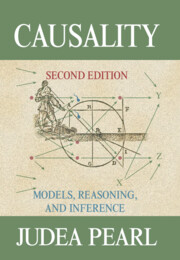Book contents
- Frontmatter
- Dedication
- Contents
- Preface to the First Edition
- Preface to the Second Edition
- 1 Introduction to Probabilities, Graphs, and Causal Models
- 2 A Theory of Inferred Causation
- 3 Causal Diagrams and the Identification of Causal Effects
- 4 Actions, Plans, and Direct Effects
- 5 Causality and Structural Models in Social Science and Economics
- 6 Simpson’s Paradox, Confounding, and Collapsibility
- 7 The Logic of Structure-Based Counterfactuals
- 8 Imperfect Experiments: Bounding Effects and Counterfactuals
- 9 Probability of Causation: Interpretation and Identification
- 10 The Actual Cause
- 11 Reflections, Elaborations, and Discussions with Readers
- Epilogue The Art and Science of Cause and Effect
- Bibliography
- Name Index
- Subject Index
9 - Probability of Causation: Interpretation and Identification
Published online by Cambridge University Press: 05 March 2013
- Frontmatter
- Dedication
- Contents
- Preface to the First Edition
- Preface to the Second Edition
- 1 Introduction to Probabilities, Graphs, and Causal Models
- 2 A Theory of Inferred Causation
- 3 Causal Diagrams and the Identification of Causal Effects
- 4 Actions, Plans, and Direct Effects
- 5 Causality and Structural Models in Social Science and Economics
- 6 Simpson’s Paradox, Confounding, and Collapsibility
- 7 The Logic of Structure-Based Counterfactuals
- 8 Imperfect Experiments: Bounding Effects and Counterfactuals
- 9 Probability of Causation: Interpretation and Identification
- 10 The Actual Cause
- 11 Reflections, Elaborations, and Discussions with Readers
- Epilogue The Art and Science of Cause and Effect
- Bibliography
- Name Index
- Subject Index
Summary
Come and let us cast lots to find out who is to blame for this ordeal.
Jonah 1:7Preface
Assessing the likelihood that one event was the cause of another guides much of what we understand about (and how we act in) the world. For example, according to common judicial standard, judgment in favor of the plaintiff should be made if and only if it is “more probable than not” that the defendant's action was the cause of the plaintiff's damage (or death). But causation has two faces, necessary and sufficient; which of the two have lawmakers meant us to consider? And how are we to evaluate their probabilities?
This chapter provides formal semantics for the probability that event x was a necessary or sufficient cause (or both) of another event y. We then explicate conditions under which the probability of necessary (or sufficient) causation can be learned from statistical data, and we show how data from both experimental and nonexperimental studies can be combined to yield information that neither kind of study alone can provide.
INTRODUCTION
The standard counterfactual definition of causation (i.e., that E would not have occurred were it not for C) captures the notion of “necessary cause.” Competing notions such as “sufficient cause” and “necessary and sufficient cause” are of interest in a number of applications, and these too can be given concise mathematical definitions in structural model semantics (Section 7.1). Although the distinction between necessary and sufficient causes goes back to J. S. Mill (1843), it has received semiformal explications only in the 1960s – via conditional probabilities (Good 1961) and logical implications (Mackie 1965; Rothman 1976). These explications suffer from basic semantical difficulties, and they do not yield procedures for computing probabilities of causes as those provided by the structural account (Sections 7.1.3 and 8.3).
In this chapter we explore the counterfactual interpretation of necessary and sufficient causes, illustrate the application of structural model semantics to the problem of identifying probabilities of causes, and present, by way of examples, new ways of estimating probabilities of causes from statistical data. Additionally, we argue that necessity and sufficiency are two distinct facets of causation and that both facets should take part in the construction of causal explanations.
- Type
- Chapter
- Information
- CausalityModels, Reasoning, and Inference, pp. 283 - 308Publisher: Cambridge University PressPrint publication year: 2009
- 1
- Cited by



